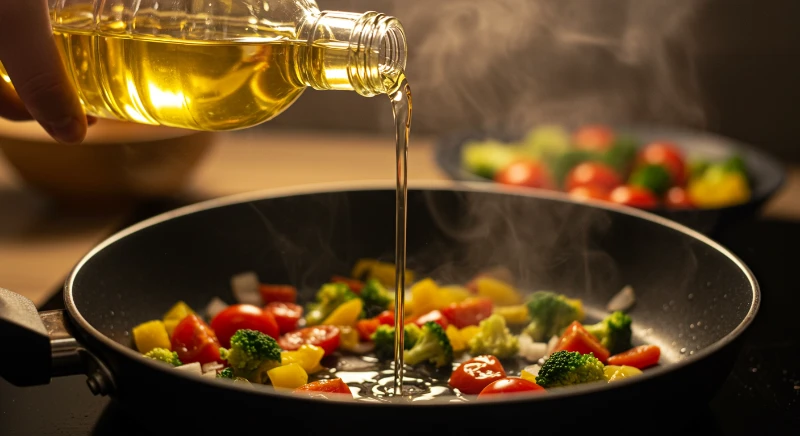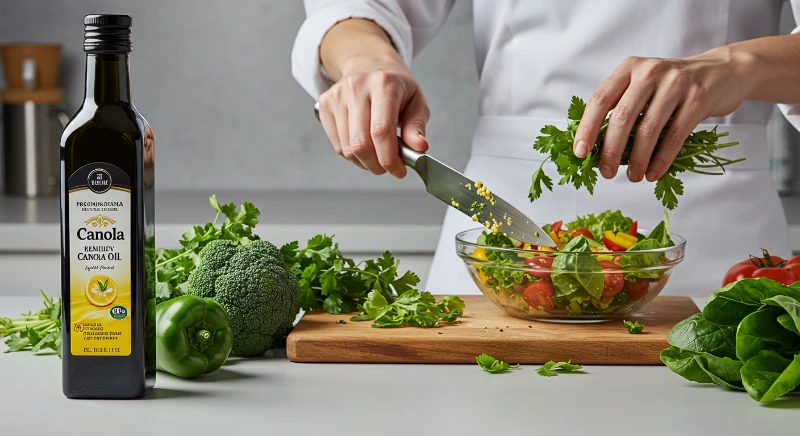Canola oil is one of the most widely used cooking oils, known for its neutral flavor, high smoke point, and potential health benefits. But what is canola oil exactly, and what is canola oil made of? Extracted from the canola plant, this oil is often compared to others like sunflower oil due to its nutrition facts and omega-3 and omega-6 content. Many wonder, is canola oil healthy or is canola oil bad for you? With concerns about its processing, ingredients, and impact on heart health, it's important to understand how canola oil is made, its calories, and whether it’s a healthy oil choice for your diet.
What is Canola Oil?
This oil became popular because it has a neutral flavor, a high smoke point, and is often marketed as a healthy oil. It’s commonly used for frying, baking, and even in salad dressings. Many people choose canola oil because it’s lower in saturated fat compared to other oils like butter or coconut oil.

The canola plant was developed in Canada in the 1970s by scientists looking for a healthier alternative to traditional rapeseed oil, which had high levels of erucic acid and was not safe for human consumption. Through breeding techniques, they created a new version of the plant with low erucic acid and low glucosinolates, making it safe to eat and more pleasant in taste.
Canola oil quickly became popular because of its light texture, mild taste, and health benefits. Today, it’s one of the most widely used oils in the food industry, found in everything from chips and margarine to home-cooked meals.
What is Canola Oil Made Of? Is Canola Oil Healthy?
Canola oil is often advertised as a heart-healthy cooking oil, but there’s a lot of debate about whether it’s actually good for you. Some people love it for its low saturated fat and omega-3 content, while others worry about its processing methods. So, is canola oil healthy, or should you avoid it? Let’s break it down. Canola oil is made almost entirely of fat, with a balance of:
- Monounsaturated fats (about 63%) – About 63% of canola oil is monounsaturated fat, which can lower bad cholesterol (LDL) and increase good cholesterol (HDL).
- Polyunsaturated fats (about 28%) – These include omega-3 and omega-6 fatty acids, which are essential for brain and heart health.
- Saturated fats (about 7%) – Only 7% of its fat is saturated, which is lower than butter, coconut oil, or palm oil. Diets lower in saturated fat are linked to better heart health.
Besides fats, canola oil contains vitamin E and vitamin K, which are good for skin health and blood clotting.
The Processing of Canola Oil
Canola oil goes through several steps before it reaches your kitchen. Here’s how it’s made:
- Harvesting – Canola plants are grown, and their small black seeds are collected.
- Cleaning – The seeds are cleaned to remove dirt and debris.
- Crushing – The seeds are crushed to release oil.
- Pressing & Extraction – The crushed seeds are pressed, and a chemical process (usually with hexane) is used to extract as much oil as possible.
- Refining – The oil is refined, bleached, and deodorized to remove any impurities and give it a light color and mild taste.
Some cold-pressed canola oils skip the chemical extraction step and use mechanical pressing instead, which is seen as a healthier and more natural option.
Canola Oil Nutrition Facts
Canola oil is often marketed as a healthy oil because it contains less saturated fat than many other cooking oils. It’s also a good source of unsaturated fats, which are beneficial for heart health. But let’s take a closer look at its nutritional breakdown.

Calories in 1 Tbsp Canola Oil
If you’re keeping track of calories, it’s important to know that 1 tablespoon of canola oil contains:
- 120 calories
- 14 grams of fat
- 0 grams of carbohydrates or protein
Like all oils, canola oil is 100% fat, which means it’s calorie-dense. If you’re watching your calorie intake, it’s best to use it in moderation.
Best Uses for Canola Oil
Canola oil is one of the most versatile cooking oils because of its neutral flavor, light texture, and high smoke point. It works well for frying, baking, and salad dressings, making it a go-to choice for both home cooks and the food industry. But how does it compare to sunflower oil, and which cooking oil is actually the healthiest?
Frying: One of the reasons canola oil is so popular is its high smoke point (about 400°F / 204°C). This means it can handle high-heat cooking without breaking down and producing harmful compounds.
Best uses for frying with canola oil:
- Deep frying (French fries, fried chicken, tempura)
- Stir-frying & sautéing (vegetables, tofu, meat)
- Pan-frying (pancakes, grilled cheese)
It’s a great option for frying because it has a neutral flavor and doesn’t overpower the taste of food.
Baking: Because of its light texture, canola oil is often used in baking as a substitute for butter or solid fats. It helps create moist and soft baked goods without adding a strong taste.
Best baking uses for canola oil:
- Cakes and muffins
- Brownies and cookies
- Breads and pizza dough
Since it’s lower in saturated fat than butter, using canola oil in baking can make your treats a bit healthier without sacrificing texture.
Salad Dressings & Sauces: Canola oil works well in salad dressings because it doesn’t have a strong taste, letting other ingredients shine. It blends well with vinegar, lemon juice, and herbs, making it a great base for homemade dressings and marinades.
Best salad dressing uses:
- Vinaigrettes
- Mayonnaise and aioli
- Marinades for meats or vegetables
If you like extra flavor, you might prefer olive oil for salad dressings instead of canola oil.

Comparison: Canola Oil vs Sunflower Oil
Both canola oil and sunflower oil are popular for cooking, but they have some key differences.
| Feature | Canola Oil | Sunflower Oil |
|---|---|---|
| Smoke Point | ~400°F (204°C) | ~440°F (227°C) |
| Flavor | Neutral | Neutral |
| Saturated Fat | 7% (Low) | 10% (Moderate) |
| Monounsaturated Fat | 63% (High) | 45% (Moderate) |
| Polyunsaturated Fat (Omega-3 & 6) | 28% (Balanced) | 40% (Mostly Omega-6) |
| Best Uses | Frying, baking, salad dressings | High-heat frying, roasting |
Which One is Better?
- For frying: Sunflower oil has a slightly higher smoke point, making it better for deep frying.
- For heart health: Canola oil is better because it has more monounsaturated fats and a better balance of omega-3 and omega-6.
- For neutral taste: Both are mild and don’t affect the flavor of food.
Winner? If you want a healthier option with less omega-6, canola oil is the better choice. If you need a super high smoke point for deep frying, sunflower oil is slightly better.
Which Cooking Oil is Good for Health?
If you’re looking for the healthiest cooking oil, it depends on your needs. Here’s a quick comparison of popular oils:
| Oil Type | Best For | Health Benefits |
|---|---|---|
| Canola Oil | Frying, baking, salads | Low in saturated fat, good balance of omega-3 & 6 |
| Olive Oil | Low-heat cooking, salads | High in monounsaturated fats, great for heart health |
| Avocado Oil | High-heat cooking, salads | High in monounsaturated fats, rich in antioxidants |
| Coconut Oil | Baking, occasional frying | High in saturated fat, may boost metabolism but raises cholesterol |
| Sunflower Oil | High-heat frying | High in omega-6, needs balance with omega-3 |
| Butter | Low-heat cooking, flavor | High in saturated fat, but contains vitamins A & D |
Final Thoughts
Canola oil is a great all-purpose oil because it works well for frying, baking, and salad dressings. Compared to sunflower oil, it has a better fat balance for heart health. But if you’re looking for the absolute healthiest oil, extra virgin olive oil or avocado oil might be better choices.
